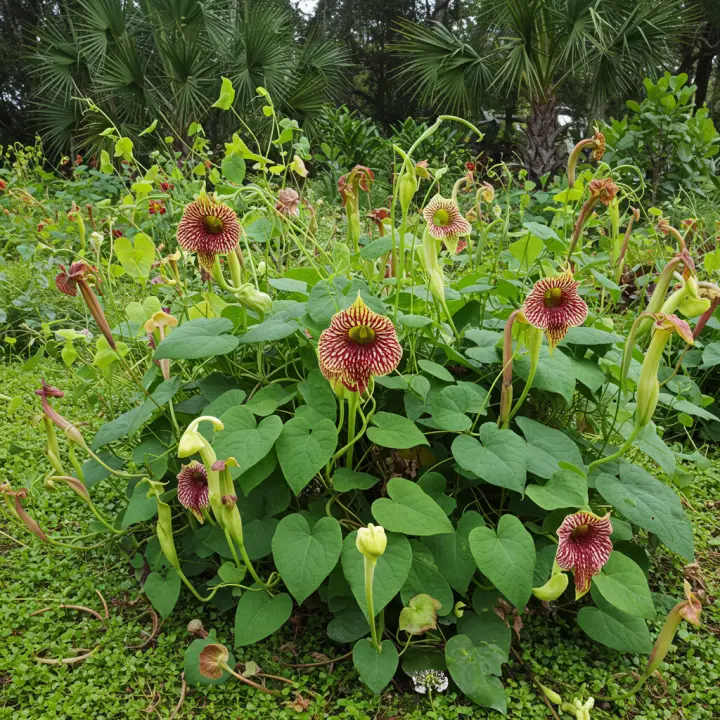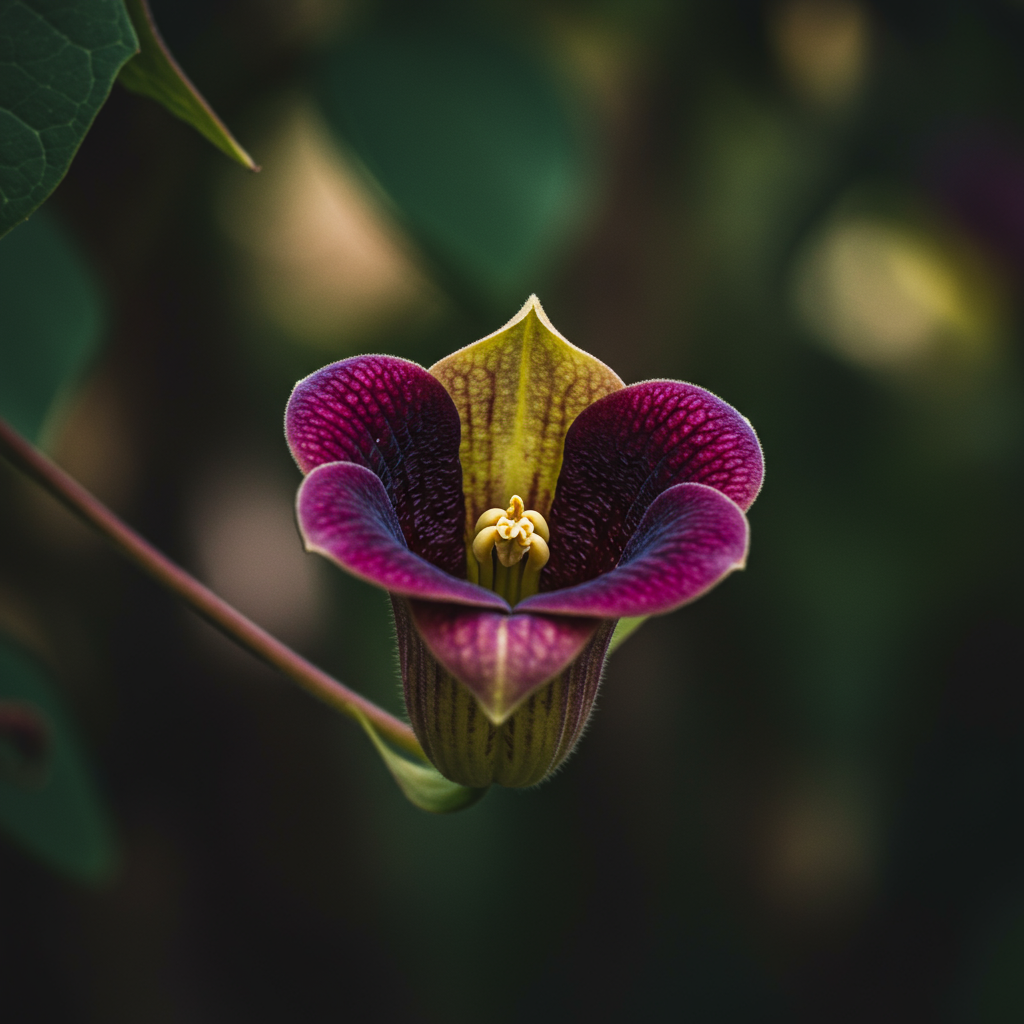Uncover the captivating world of Aristolochia for Florida gardens, featuring unique, often bizarre blooms and their essential role as host plants for the magnificent Pipevine Swallowtail butterfly. This comprehensive guide shares the best Aristolochia varieties perfectly suited for Florida’s climate, along with expert growing tips to transform your outdoor space into a vibrant, butterfly-friendly haven.

Unveiling Aristolochia: A Florida Gardener’s Delight
Imagine a vine boasting exotic, often curiously shaped flowers that look like something out of a botanical art piece, all while serving as a crucial lifeline for stunning butterflies. That’s the magic of Aristolochia, commonly known as Dutchman’s Pipe vine. With over 500 species globally, these fascinating plants offer a unique blend of ornamental beauty and ecological significance, making them an exceptional choice for the Florida garden. Their adaptability to our warm, humid climate, combined with their role as host plants for specific butterfly species, makes them a standout addition for any gardener seeking both beauty and biodiversity.
What is Aristolochia? Understanding the Dutchman’s Pipe Vine
Aristolochia is a genus of flowering plants known for its distinctive, often-lobed leaves and its remarkably unique flowers. These blooms are typically tubular or “pipe-shaped,” leading to their common moniker, Dutchman’s Pipe. Their intricate patterns and sometimes surprising colors make them true conversation starters in the landscape.
The Allure of Unique Blooms
Aristolochia flowers range in size from small and delicate to extraordinarily large and dramatic. Many species feature fascinating patterns and hues, from deep purples and maroons to mottled creams and yellows, often resembling something velvety or reptilian. Their unusual structure is not just for show; it’s a clever mechanism designed to trap insects temporarily for pollination.
A Vital Host Plant: The Butterfly Connection
Beyond their aesthetic appeal, Aristolochia species are ecologically invaluable. They are the sole host plants for the caterpillars of the Pipevine Swallowtail butterfly (Battus philenor), and sometimes other swallowtail species. Without Aristolochia, these stunning blue-black butterflies cannot complete their life cycle. By planting these vines, you provide essential food for their larvae, directly supporting local butterfly populations.
Why Aristolochia Thrives in Florida’s Climate
Florida’s subtropical to tropical climate, characterized by warm temperatures, ample rainfall, and high humidity, provides an ideal environment for many Aristolochia species. Originating largely from tropical and subtropical regions, these vines are naturally adapted to conditions that might challenge other plants. The long growing season allows them to establish quickly and flourish, producing abundant foliage and spectacular blooms. They are especially suited for USDA Hardiness Zones 9-11, which cover most of Florida.
Top Aristolochia Species for Florida Gardens
Choosing the right Aristolochia can elevate your Florida garden. Here are some of the best varieties that thrive in our unique climate:
_Aristolochia gigantea_ (Giant Brazilian Dutchman’s Pipe): As its name suggests, this species boasts truly enormous, velvety purple and cream flowers, some reaching over a foot in length! It’s a true showstopper, requiring sturdy support and plenty of space. Its dramatic appearance makes it a focal point in any tropical garden.
_Aristolochia littoralis_ (Calico Flower): Also sometimes referred to as _A. elegans_, this vigorous vine produces charming, pipe-shaped flowers that are mottled with brown, purple, and cream, resembling calico fabric. It’s an enthusiastic grower, providing quick coverage for trellises and fences, and is an excellent host plant.
_Aristolochia fimbriata_ (Fringed Pipevine): A smaller, more restrained species, _A. fimbriata_ is often used as a groundcover due to its creeping habit. Its delicate, fringed, yellow-green flowers with purple veining are unique. This compact plant is perfect for smaller spaces or alongside pathways, still offering vital support to Pipevine Swallowtails.
_Aristolochia tomentosa_ (Woolly Dutchman’s Pipe): Native to parts of the southeastern U.S. (including northern Florida), this species is extremely hardy and adaptable. It features heart-shaped leaves covered in soft hairs and yellow-green, pipe-shaped flowers. It’s a robust choice for those seeking a more native or cold-tolerant option within Florida.
Growing and Caring for Your Aristolochia Vine
To ensure your Aristolochia flourishes, follow these essential growing and care tips:
Ideal Planting Location
Sunlight: Most Aristolochia species prefer a location with partial shade to full sun. In the intense Florida summer sun, some dappled shade during the hottest part of the day can prevent leaf scorch, especially for species with delicate foliage.
Soil Preferences: They thrive in well-draining, fertile soil rich in organic matter. Amending sandy Florida soils with compost or peat moss before planting will provide an excellent foundation.
Watering and Fertilizing
Watering: Keep the soil consistently moist, especially during establishment and dry periods. However, avoid waterlogging, as this can lead to root rot. A layer of mulch can help retain soil moisture.
Fertilizing: A balanced, slow-release granular fertilizer applied in spring, or regular applications of a liquid feed during the growing season, will support vigorous growth and blooming. Follow package directions for application rates.
Support Structures and Pruning
Support: As vining plants, Aristolochia require a sturdy support structure like a trellis, arbor, fence, or even another tree. Guide young shoots initially to encourage them to climb.
Pruning: Prune after the main flush of blooms or in late winter/early spring to maintain shape, control size, and remove any dead or overgrown stems. This also encourages bushier growth and more flowers. Some vigorous species may require more frequent trimming.
Pest and Disease Management
Aristolochia are generally robust plants. The most common “pest” you’ll likely encounter is the Pipevine Swallowtail caterpillar – a welcome sight! Beyond that, keep an eye out for:
Spider mites: Especially in dry conditions; treat with horticultural oil or insecticidal soap.
Aphids: Can be hosed off with water or treated with insecticidal soap.
Fungal issues: Good air circulation and avoiding overhead watering can help prevent fungal spots in Florida’s humidity.
The Ecological Impact: A Haven for Butterflies
Planting Aristolochia is one of the most direct ways to support the lifecycle of the Pipevine Swallowtail butterfly. Female butterflies seek out these specific vines to lay their eggs. Once hatched, the caterpillars feed exclusively on the Aristolochia leaves, absorbing compounds that make them distasteful to predators – a vivid warning sign often indicated by their dark coloration and orange spines. Watching these caterpillars grow and transform into chrysalises, and then emerge as beautiful butterflies, is a truly rewarding experience for any gardener.
Important Considerations for Aristolochia in Florida Gardens
Before planting, it’s good to be aware of a few key aspects of Aristolochia.
Toxicity
Many Aristolochia species contain aristolochic acids, which are toxic if ingested. These compounds are medically significant, and the plant should not be consumed by humans or pets. While the Pipevine Swallowtail caterpillars process these toxins, making them unpalatable to birds, other animals can be harmed. It’s wise to locate these plants away from areas where curious children or pets might ingest them.
Propagation
Aristolochia can be propagated from seeds, cuttings, or by layering. Cuttings taken from semi-hardwood stems in spring or summer often root well in a humid environment.
Managing Vigor
Some Aristolochia varieties, particularly _A. littoralis_ and _A. gigantea_, can be very vigorous growers in Florida’s favorable climate. While this is great for quick coverage and butterfly support, it means they might require regular pruning to keep them within bounds and prevent them from overwhelming smaller plants or structures.
Frequently Asked Questions (FAQs) About Aristolochia
Q: Is Aristolochia toxic to humans or pets?
A: Yes, many Aristolochia species contain aristolochic acids, which are toxic if ingested. It’s best to plant them in areas where children and pets won’t easily access and chew on the leaves.
Q: How fast does Aristolochia grow in Florida?
A: Aristolochia vines are generally fast-growing, especially in Florida’s warm, humid climate with adequate water and nutrients. Many can add several feet of growth in a single season.
Q: What butterflies does Aristolochia attract?
A: Aristolochia vines are the sole host plants for the caterpillars of the striking Pipevine Swallowtail butterfly (Battus philenor). They may also attract other generalist pollinators with their unique flowers.
Q: Does Aristolochia need full sun in Florida?
A: Most Aristolochia species prefer partial shade to full sun. In the intense Florida afternoon sun, some dappled shade can be beneficial to prevent leaf scorching.
Q: Can Aristolochia be grown in pots?
A: Yes, smaller or slower-growing Aristolochia species like A. fimbriata can be successfully grown in large pots or containers, provided they have adequate drainage, support, and consistent moisture. Larger, more vigorous varieties may outgrow pots quickly.
Conclusion: Embrace the Exotic Beauty of Aristolochia in Your Florida Garden
Adding Aristolochia for Florida gardens is more than just choosing a beautiful vine; it’s an invitation to a unique botanical experience and a commitment to local wildlife. With their captivating, pipe-shaped blooms and their indispensable role as host plants for the Pipevine Swallowtail, these vines bring an exotic flair and a vibrant ecosystem into your backyard. Whether you opt for the dramatic show of A. gigantea or the charming vigor of A. littoralis*, Aristolochia promises to be a stunning, rewarding, and truly fascinating addition to your Florida landscape. Start your Aristolochia journey today and watch your garden come alive!

